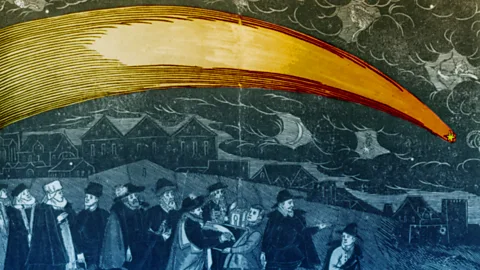Don't Look Up: The stories that reflect our oldest fear
 Alamy
AlamyAdam McKay's star-filled apocalyptic disaster comedy is the latest in a centuries-old genre of fiction about threats from space, writes Dorian Lynskey.
Sometimes publicity falls out of the sky. On 24 November, just a couple of weeks before Adam McKay's apocalyptic disaster comedy Don't Look Up opened in cinemas, Nasa launched a spacecraft called Dart (Double Asteroid Redirection Test) to see if it could alter the trajectory of the moonlet Dimorphos. That particular chunk of rock turns out to be no danger to Earth. Not so the Everest-sized comet in Don't Look Up, which is only six months away at the beginning of the movie. With a cast led by Leonardo DiCaprio, Jennifer Lawrence and Meryl Streep, McKay's film is a striking example of what you might call "impact fiction", a diverse sub-genre of apocalyptic fiction that goes all the way back to Edgar Allen Poe and is currently enjoying (if enjoying is the right word) a major revival.
More like this:
Comets and asteroids are interchangeable in impact fiction, and with good reason. Both are stray bits of rubble left over from the formation of the solar system. A comet is a globe of ice, rock, dust and gas, originating in the outer solar system. When comets the sun, they shed a trail of gas and debris, hence the tail: the Greek word kometa means long-haired. An asteroid (meaning star-like) is a chunk of rock and minerals from the asteroid belt between Jupiter and Mars: no ice, no tail.
Despite their differences, the effect of a significant collision with the Earth would be much the same, which is why all potentially dangerous bodies now come under the umbrella of Near-Earth Objects (NEOs). The largest impact event in recorded history is the 12-megaton aerial explosion near the Tunguska river in Siberia on 30 June 1908, but that was a pebble compared to the one that wiped out the dinosaurs in the Cretaceous-Paleogene (K-Pg) extinction event 66 million years ago. Studies of K-Pg, a six-to-nine-mile-wide object making landfall with an estimated force of 100 million megatons, indicate what a similar impact might look like.
 Netflix
NetflixFirst, the blast waves would level everything within a radius of several hundred miles while triggering earthquakes, tsunamis and volcanic eruptions. Worse, the impact would excavate a crater several miles deep, flinging billions of tons of rock, dust and sulphur halfway to the moon. Heavier objects would burn up on re-entering the atmosphere and create a lethal meteor shower, igniting firestorms. Smaller debris would form a thick, sun-blocking cloud around the planet, plunging it into a year-long "impact winter". Vegetation would perish within weeks and most animal life within months – if not from starvation then from sulfuric rain as corrosive as battery acid or UV radiation pouring through the shredded ozone layer. The Earth's surface would cease to sustain life.
Nasa calculates the annual odds of an impact equivalent to K-Pg as one in a million but, as the opening voiceover in Michael Bay's 1998 movie Armageddon dramatically puts it: "It happened before. It will happen again. It's just a question of when">window._taboola = window._taboola || []; _taboola.push({ mode: 'alternating-thumbnails-a', container: 'taboola-below-article', placement: 'Below Article', target_type: 'mix' });
